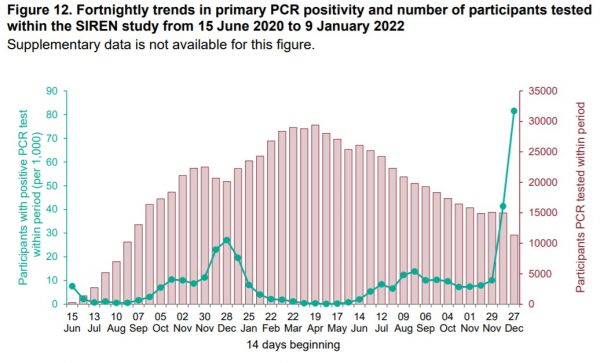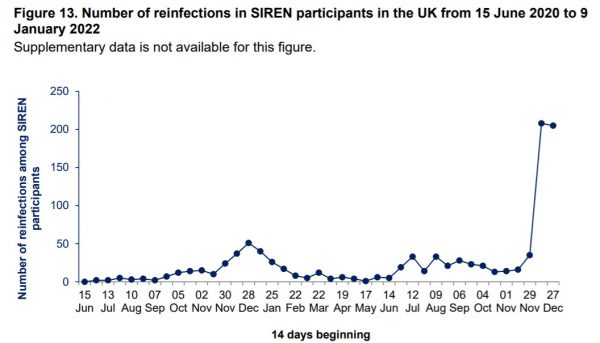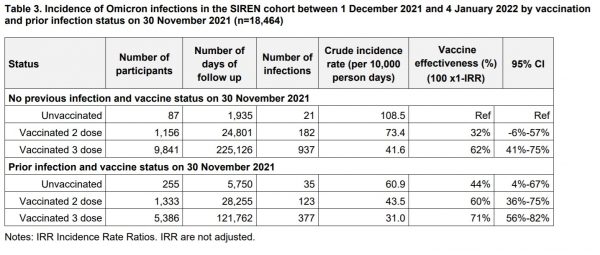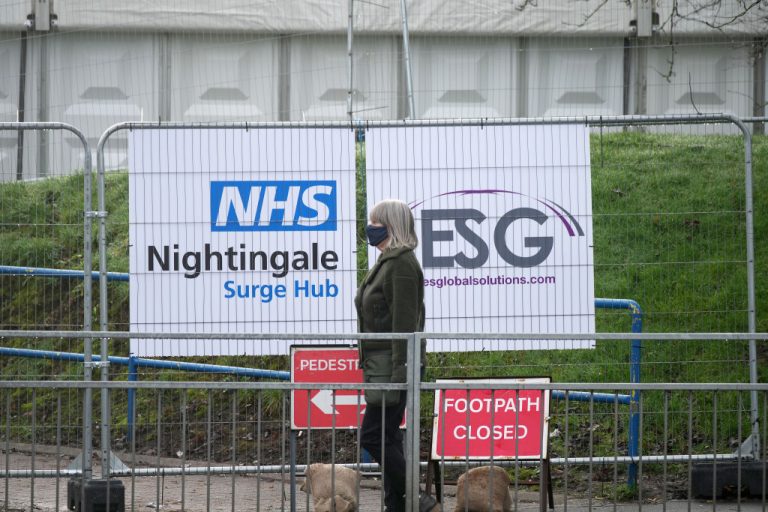A new data analysis document compiled by a UK government agency reveals that National Health Services (NHS) staff, which boasts a greater than 95 percent vaccine acceptance rate, have suffered a startling eight fold increase in positive COVID tests with the advent of the Omicron variant of SARS-CoV-2, the pathogen that causes Coronavirus Disease 2019 (COVID-19).
Data also showed that unvaccinated NHS staffers with natural immunity from previous infection had a lower incidence ratio of positive Omicron tests than their double vaccinated colleagues who did not possess natural immunity.
The finding was disclosed in the UK Health Security Agency’s Jan. 14 Technical Briefing on SARS-CoV-2 variants of concern. The Briefing cited data from the SARS-CoV-2 Immunity and Reinfection Evaluation (SIREN) study.
The paper elucidates, “The SIREN study is a cohort of over 44,000 National Health Service healthcare workers, recruited from 135 hospital sites UK-wide. Participants under active follow-up undergo asymptomatic SARS-CoV-2 PCR testing every 2 weeks.”
RELATED ARTICLES:
- Ontario Study: Double Jabs Give Negative Vaccine Efficacy Against Omicron, 95 Percent of Cases Fully Vaccinated
- Apple Watch Records Two Days of Arrhythmia Leading Up To Death of 26-Year-Old Following Pfizer Booster
- COVID Is Actually a US-CCP Bat Vaccine Joint Project Gone Wrong, Writes DARPA Fellow In Letter to Inspector General
Success
You are now signed up for our newsletter
Success
Check your email to complete sign up
It notes that the NHS staff tracked have a “high seropositivity [antibodies from previous infection] on recruitment” of approximately 30 percent, and “is now highly vaccinated (>95%).”
A second table later in the SIREN examination indicates booster injection acceptance is greater than 82 percent in a significant subsection of this group.
A plot generated from biweekly PCR testing showed the incidence rate of positive PCR tests in the SIREN cohort through the first six months of 2021 was close to zero per 1,000 participants.
The incidence rate increased to approximately 10 per 1,000 participants starting in July and remained relatively flat thereafter, before a sudden exponential increase above 40 in mid-December.
The figure achieved an eightfold growth rate of more than 80 in Dec. 27, 2021’s reporting.

One of the earliest dates chronicling the emergence of Omicron was in four fully vaccinated diplomats from an undisclosed country who visited Botswana on Nov. 7, testing positive for SARS-CoV-2.
The country’s genomic surveillance system confirmed the infection was a new variant, but not until more than three weeks later on Nov. 24.
Omicron has since quickly replaced the previous Delta variant as the predominant strain of SARS-CoV-2 in most of the world.
Additionally, SIREN also revealed that Omicron was hitting the almost entirely-vaccinated NHS staff who had previous infection with a similarly exponential, albeit more muted, response.
The UKHSA defined reinfections as “new PCR positive infections 90 days after a previous PCR positive date or 28 days after antibody positivity consistent with prior infection.”
A data plot ranging from June 15, 2020 to Jan. 9, 2022 revealed that the absolute number of infections in the previously-infected cohort ranged from between zero and approximately 35 per reporting period through the vast majority of 2021.

However, both reporting periods in December revealed an exponential increase in reinfections to approximately 200.
A second data cluster examined vaccine efficacy in the SIREN cohort against Omicron, this time examining a smaller subset of 18,464 participants from December of 2020 to Jan. 4, 2022.
The UKHSA did not clearly explain why a subset of the original 44,000 NHS staff was chosen, only noting that the group was “remaining under active follow-up during this period.”
The cluster was divided by vaccination and previous infection status as of Nov. 30, 2021, and examined for either symptomatic or asymptomatic positive PCR test or reinfection.
Reinfections were considered as such if a staffer registered a positive PCR test 90 days or later after a previous PCR positive, or 28 days after testing positive for antibodies in addition to having documented a previous infection.
This cohort was composed of 11,084 members with no evidence of prior infection and 6,974 members with previous infection. Approximately 82.4 percent of all participants were fully vaccinated and boosted, while an additional 13.4 percent were only double vaccinated.
The examination, which explored data in a short period from Dec. 1, 2021 to Jan. 4, 2022, found 1,675 positive tests, for an overall infection ratio of approximately 9 percent.
55 percent of all positive cases occurred in the triple vaxxed who lacked exposure to previous infection.
Among 9,841 triple-vaxxed members without previous infection, there were 937 positive Omicron cases, amounting to approximately 9.5 percent positive test ratio. Among the double vaccinated, these figures were 1,156 participants with 182 infections, amounting to a 15.7 percent positivity rate.

Among 87 the unvaccinated and uninfected NHS staffers included in the cohort, 21 tested positive, amounting to slightly more than 24 percent.
Notably, the smaller cohort possessing previous infection showed a reduced infection ratio across all tiers of vaccination status. Among 5,386 triple-vaxxed NHS members, there were 377 positives, resulting in a 6.9 percent positive ratio. 1,333 double-vaxxed returned 123 positives, returning a 9.2 percent positivity rate.
Among the 255 unvaccinated NHSers who also possessed antibodies from previous infection, there were 35 positives, amounting to a 13.7 percent positivity ratio, which is better than the double vaccinated fared in the cohort with no previous infection.
















